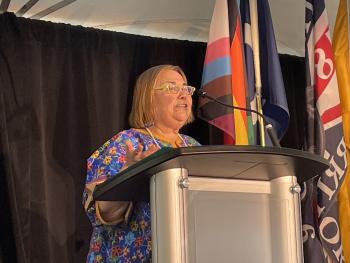Image Caption
Summary
Local Journalism Initiative Reporter
Windspeaker.com
Earlier this month members of the University of Alberta faculty, students and guests of the school celebrated the official launch of its Braiding Past, Present and Future: The University of Alberta Indigenous Strategic Plan.
“This plan reflects an important step in our institution’s commitment to reconciliation in post-secondary education, research and addressing the historical legacy of the residential school system and Canada’s colonial history in a meaningful and lasting way,” it states the website.
The event highlighted many speakers, traditional ceremony and powwow dancers.
Dr. Florence Glanfield, a former student of the university and current employee, was involved in the development of the plan with the Indigenous Advisory Council.
The council consisted of 22 First Nation, Inuit and Métis employees of the university who worked together to develop the plan.
“Today is so darn special,” said Glanfield. “I want you to know that 46 years ago I arrived at the University of Alberta as a 17-year-old to study in the faculty of science. It was the only University for a little Métis girl from Northeastern Alberta at the time.”
“I told somebody, some older human, that I was Native. And the first thing that came out of their mouth was ‘I didn’t think you people could do mathematics.’ For 46 years I have carried that story ... I want you to know that Native people can do mathematics, but we can do medicine, we can do science, we can do engineering, we can do literature, we can do education, we can do any of it.”
Ganfield explained that when the school was built it was done so without the concept that Indigenous individuals would be receiving their education at the facility. Over the years, and through the decades, the system and its ideologies have developed to be more inclusive of all people.
“But we wouldn’t be here if we didn’t have Elders and knowledge keepers who came before us to push the University of Alberta to do and welcome diversity into the space,” she said. “This institutional plan is our letter and our recognition as Indigenous employees and students at this university. This is an honour of all of the work for the trailblazers that led the way for us to be here to see ourselves achieve our dreams through a university education.”
The strategic plan incorporates three main categories, including looking to the past, “in-powering” the present, and imagining the future.
Outlined under the three subheadings are areas in which the facility will continue to educate those who attend the school as students, teachers and visitors while also continuing to establish stronger understandings of Indigenous people and culture.
Within the strand of Looking to the Past, the university outlined many ways it will move forward, including with Indigenous leadership and co-ordination, accountability and reporting, Indigenous ways of knowing, reconciliation research and scholarships.
The In-Powering the Present section focuses on areas of recruitment, retention and completion for Indigenous students, student attainment and tackling barriers, recruitment and retainment of Indigenous staff, and providing safe and welcoming spaces.
Lastly, in the final strand of the braid, Imagining the Future, it highlights areas where research will be done with Indigenous nations, peoples and on the land, Indigenous-led research for capacity development, community engagement, innovative funding, and recognition of the University of Alberta alumni to name a few.
“At the heart of the plan is the sweetgrass teachings, which teach us about our responsibility, and it is why the plan is called Braiding Past, Present and Future. The sweetgrass teachings teach us to honour those who have walked the path before us, support one another in the present and be mindful that everything we do shapes those to come. Everything we do. That braiding past, present and future are in the moment,” said Glanfield.
She explained that throughout all areas of the plan there are references to the Truth and Reconciliation Commission Calls to Action.
In 2015, the Truth and Reconciliation Commission outlined 94 calls to action that included areas relating to child welfare, education, health, justice, language and culture. They set out responsibilities for all governments, corporations, sports organizations, police, educational institutions and more to work towards reconciliation with Indigenous peoples.
The University of Alberta Indigenous Strategic Plan was developed around those calls to action.
“It has been more imperative over the last couple of years, as all Canadians and all people who call this place now called Canada home are coming to understand the relationship between the colonial governance systems and the First Nation, Métis, Inuit across this land,” explained Glanfield.
Local Journalism Initiative Reporters are supported by a financial contribution made by the Government of Canada.

